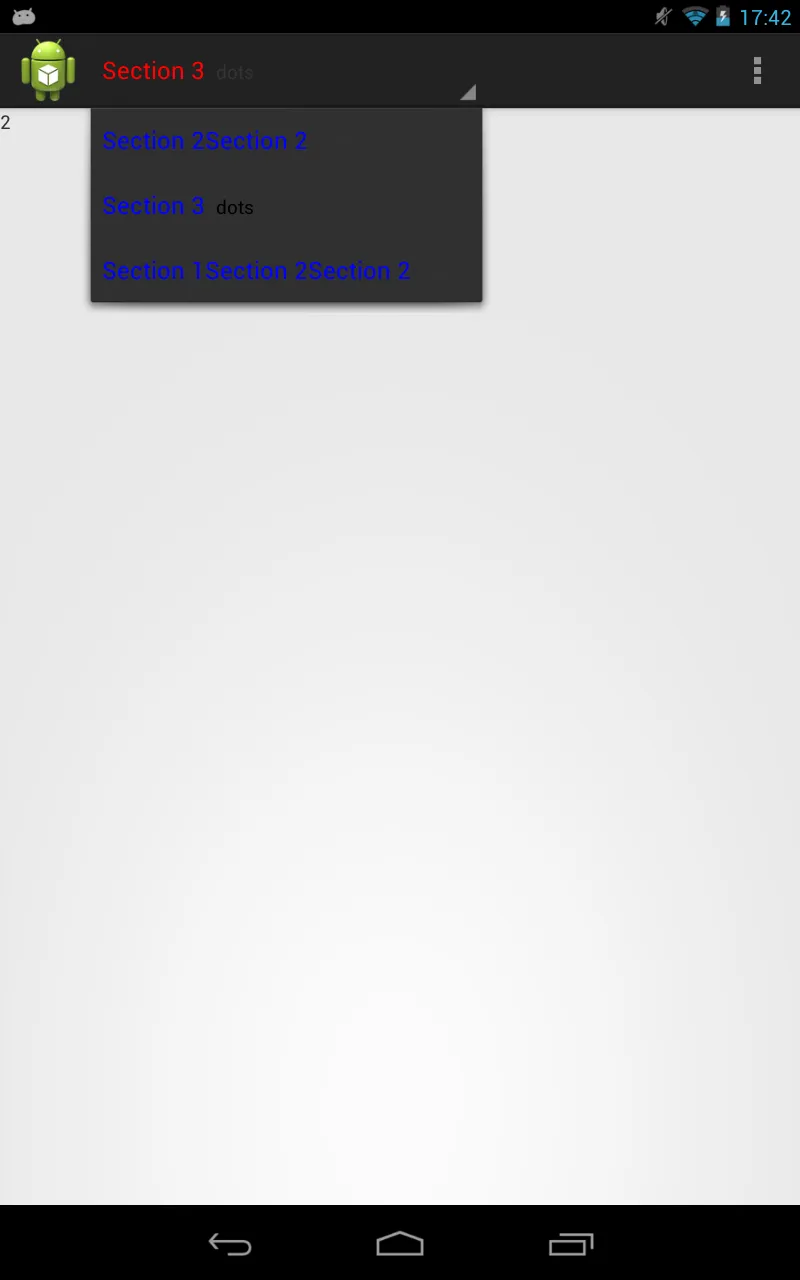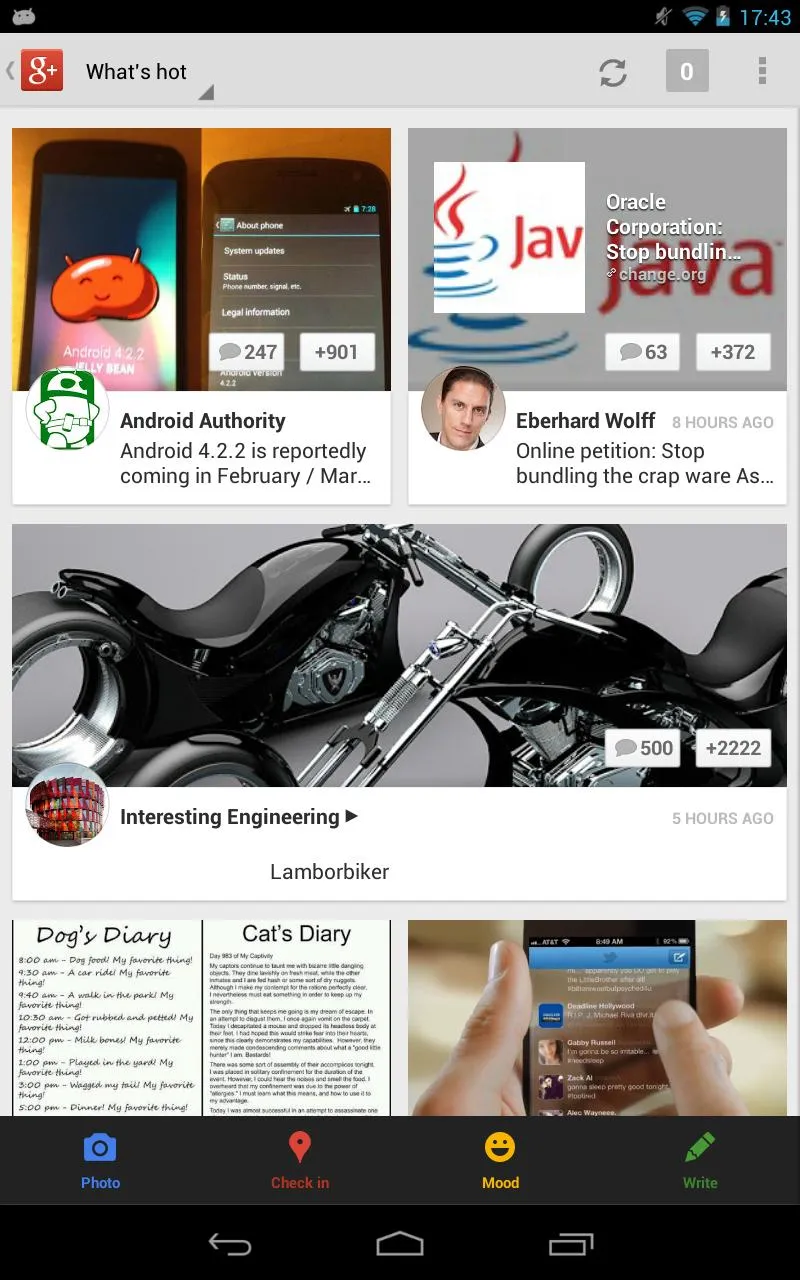默认情况下,在操作栏列表导航中,选定项的宽度与最宽的项一样宽。我想在选定项中使用“wrap_content”,就像 Google+、Gmail 和 Maps Android 应用程序中一样。
有人知道如何做吗?
我尝试了覆盖导航适配器的getView方法,但它不起作用。看起来,此视图包含另一个视图,该视图具有最宽项的宽度。我还尝试了actionbar.setCustom view与spinner,但spinner的行为相同。它使用最宽的项宽度。
感谢所有建议、链接和帮助。


默认情况下,在操作栏列表导航中,选定项的宽度与最宽的项一样宽。我想在选定项中使用“wrap_content”,就像 Google+、Gmail 和 Maps Android 应用程序中一样。
有人知道如何做吗?
我尝试了覆盖导航适配器的getView方法,但它不起作用。看起来,此视图包含另一个视图,该视图具有最宽项的宽度。我还尝试了actionbar.setCustom view与spinner,但spinner的行为相同。它使用最宽的项宽度。
感谢所有建议、链接和帮助。


我遇到了同样的问题。看起来 Android 会为所有的项调用 getView() 方法,最后将宽度设置为最宽的项的宽度。
所以这是我的解决方案:
在你的代码中存储当前选择的部分(例如你的示例中的部分),称为 selectedSection。实际上,你必须在 NavigationListener 的 onNavigationItemSelected() 方法中执行此操作。
覆盖 SpinnerAdapter 的 getView() 方法,总是将其内容设置为 selectedSection。
在 NavigationListener 的 onNavigationItemSelected() 方法中,当你将当前模式设置为 selectedSection 后,尝试调用 spinnerAdapter 的 notifyDataSetChanged() 方法。
这是示例代码:
final int selectedSection = 0;
final String sectionLabels[] = {"short sec", "long section", "looooonger section"};
final ArrayAdapter<String> arrayAdapter =
new arrayAdapter<String>(this, simple_list_item_1) {
@Override
public int getCount() {
// You need to implement here.
}
@Override
public View getView(int position, View convertView, ViewGroup parent) {
if (convertView == null) {
convertView = LayoutInflater.from(getContext()).inflate(R.layout.you_entry, null);
}
TextView textView = (TextView) convertView.findViewById(R.id.you_text);
// Set the text to the current section.
textView.setText(sectionLabels[selectedSection]);
}
@Override
public View getDropDownView(int position, View convertView, ViewGroup parent) {
// You need to implement here.
}
}
actionBar.setListNavigationCallbacks(navigationAdpater,
new ActionBar.OnNavigationListener() {
@Override
public boolean onNavigationItemSelected(int itemPosition, long itemId) {
// Store the current section.
selectedSection = itemPosition;
navigationAdpater.notifyDataSetChanged();
return true;
}
});
您需要在适配器中覆盖getView()方法,并将布局参数设置为TextView以包裹内容。选定的项目会自动调整下拉列表的大小。
我创建了一个扩展自ArrayAdapter的自定义适配器:
public class CustomAdapter extends ArrayAdapter<String> {
@Override
public View getView(final int position, final View convertView, final ViewGroup parent) {
View view = convertView;
if (null == view) {
view = LayoutInflater.from(this.getContext())
.inflate(android.R.layout.simple_list_item1, null);
((TextView) view).setText(getItem(position));
}
final LayoutParams params = new LayoutParams(LayoutParams.WRAP_CONTENT,
LayoutParams.WRAP_CONTENT);
view.setLayoutParams(params);
return view;
}
List<String> stringList = new ArrayList<String>();
stringList.add("test1");
stringList.add("test12");
stringList.add("test123");
stringList.add("test1234");
final SpinnerAdapter adapter = new CustomAdapter(this.getContext(),
android.R.layout.simple_list_item1,
android.R.id.text1,
stringList);
mySpinner.setAdapter(adapter);
当您在列表中选择某个项目时,旋转器将重新创建视图,将所选项目重新排序到第一位置,并调整大小以适应内容的大小。
这对我有用。重要的部分是这个。将下面的代码放在适配器上方,并使用selectedItemPosition从对象数组中选择文本。
int selectedItemPosition = position;
if (parent instanceof AdapterView) {
selectedItemPosition = ((AdapterView) parent)
.getSelectedItemPosition();
}
public View getView(int position, View convertView, ViewGroup parent) {
LayoutInflater inflater = getLayoutInflater();
final View spinnerCell;
if (convertView == null) {
// if it's not recycled, inflate it from layout
spinnerCell = inflater.inflate(R.layout.layout_spinner_cell, parent, false);
} else {
spinnerCell = convertView;
}
int selectedItemPosition = position;
if (parent instanceof AdapterView) {
selectedItemPosition = ((AdapterView) parent)
.getSelectedItemPosition();
}
TextView title = (TextView) spinnerCell.findViewById(R.id.spinnerTitle);
title.setText(titles[selectedItemPosition]);
return spinnerCell;
}
如果您需要解释,请访问此链接:http://coding-thoughts.blogspot.in/2013/11/help-my-spinner-is-too-wide.html
android:layout_width="0"
android_layout_weight="0.3"
这意味着旋转器将仅占屏幕宽度的三分之一。
在文本视图上,您将设置:
android:singleLine="false"
android:ellipsize="end"